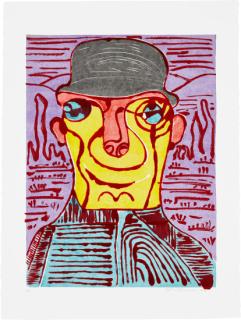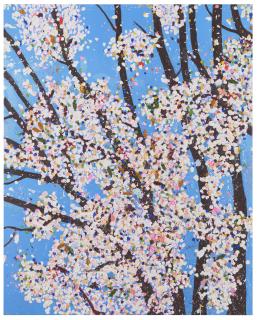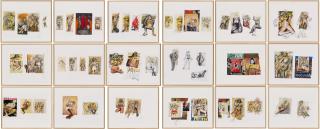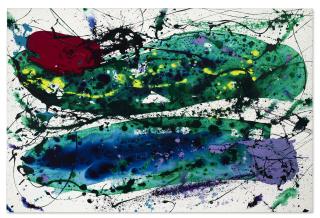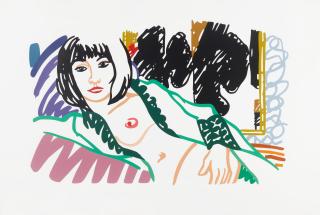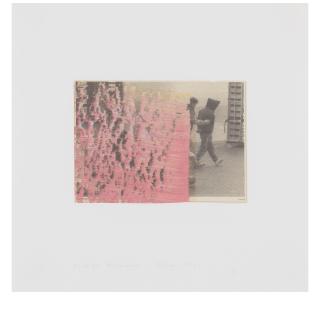Nicole Eisenman born 1965
The artist Nicole Eisenman
- Is a contemporary US-American artist.
- Her figurative paintings comment on current political and cultural conditions.
- The multi-faceted style of her work cites art history, among others.
The artist Nicole Eisenman was born in 1965 in Verdun, France and grew up in the USA. She studied painting at the Rhode Island School of Design in Providence until 1987 and now lives and works in New York. In 2015, she won the McArthur Fellowship, which honours special achievements by US-Americans regardless of their profession. Eisenman's œuvre spans painting, drawing, printmaking and sculpture and is stylistically extremely diverse. The artist is best known for her figurative paintings.
In her work, Eisenman deals with contemporary issues that have an impact on human (co)life: Politics, climate change, LGBTQ+, patriarchal structures and feminism, technological advances, and anonymity in the globalised world. Eisenman herself is lesbian and Jewish. It is her own emotions and experiences, but also the significance for society as a whole, that she addresses in her works. As serious as the themes are: In her paintings, the artist works satirically and caricatured, the figures seem to arise from a comic and often stand, allegorically alienated, for an extra-pictorial object.
Eisenman also incorporates art-historical cross-references into her works, for example to Goya's depictions of war or Picasso's portraits of women. She contrasts them with an updated perspective: Groups of people are no longer in the Spanish Civil War, but on feminist demonstrations, Picasso's Male-Gaze is negated by Eisenman's depiction of a masturbating figure - painted in the Spaniard's manner. The painting The Triumph of Poverty, which can be read as a paraphrase of the 2008 financial crisis, also quotes art history; here it is the same-named painting by Hans Holbein the Younger.
Eisenman not only adapts the painting styles, compositions or motifs of her artist colleagues and transfers them into a satirical-critical pictorial world, but also develops her own, albeit still strongly varying, painting style. It ranges from a high materiality and technical precision to the objectification of impasto paint.
Die Künstlerin Nicole Eisenman
- Ist eine zeitgenössische US-amerikanische Künstlerin.
- Ihre figurativen Malereien kommentieren aktuelle politische und kulturelle Zustände.
- Der facettenreiche Stil ihrer Arbeiten zitiert unter anderem die Kunstgeschichte.
Die Künstlerin Nicole Eisenman wurde 1965 in Verdun, Frankreich geboren und wuchs in den USA auf. An der Rhode Island School of Design in Providence studierte sie bis 1987 Malerei, heute lebt und arbeitet sie in New York. 2015 gewann sie das McArthur-Stipendium, welches besondere Verdienste von US-Amerikanern unabhängig ihres Berufs würdigt. Eisenmans Œuvre erstreckt sich über Malerei, Zeichnung, Druckgrafik und Skulptur und ist stilistisch äußerst divers. Am bekanntesten ist die Künstlerin für ihre figurativen Malereien.
In ihren Arbeiten beschäftigt sich Eisenman mit zeitgenössischen Themen, die Einfluss auf das menschliche (Zusammen-)Leben haben: Politik, Klimawandel, LGBTQ+, patriarchale Strukturen und Feminismus, technische Fortschritte sowie Anonymität in der globalisierten Welt. Eisenman selbst ist lesbisch und jüdisch. Es sind ihre eigenen Emotionen und Erlebnisse, aber auch die Bedeutung für die gesamte Gesellschaft, die sie in ihren Werken behandelt. So ernst die Themen auch sind: In ihren Bildern arbeitet die Künstlerin satirisch und karikierend, die Figuren scheinen einem Comic zu entspringen und stehen häufig, allegorisch verfremdet, für einen außerbildlichen Gegenstand.
Zudem baut Eisenman kunstgeschichtliche Querverweise in ihre Werke ein, etwa auf die Kriegsdarstellungen Goyas oder die Frauenporträts von Picasso. Sie setzt ihnen eine aktualisierte Perspektive entgegen: Menschengruppen befinden sich nicht mehr im Spanischen Bürgerkrieg, sondern auf feministischen Demonstrationen, Picassos Male-Gaze negiert Eisenman durch die Darstellung einer masturbierenden Figur – gemalt in der Manier des Spaniers. Auch das Bild The Triumph of Poverty, welches als Paraphrase auf die Finanzkrise 2008 gelesen werden kann, zitiert die Kunstgeschichte, hier ist es das gleichnamige Bild von Hans Holbein dem Jüngeren.
Eisenman adaptiert nicht nur die Malstile, Kompositionen oder Motive ihrer Künstlerkollegen und überführt sie in eine satirisch-kritische Bildwelt, sondern entwickelt einen eigenen, wenngleich weiterhin stark variierenden, Malstil. Er reicht von einer hohen Stofflichkeit und technischer Präzision bis zur Gegenstandswerdung von pastoser Farbe.
Nicole Eisenman in a nutshell
Nicole Eisenman is one of the most important figurative painters of the present. She is primarily concerned with the human condition, which she translates into emotional and cartoonesque figures, adding a touch of humor. Eisenman adapts the painting style of recognized colleagues and caricatures their respective world views, for instance by inverting well-known scenes by Goya or Picasso. Eisenman uses queer motifs out of personal concern, which she expresses through intense colors: scenes of mythical creatures, gatherings of people, surreal creatures, or abstract portraits that hint at human features testify to Eisenman's changeable ductus. She brings both her variable style and technique to life in her prints, paintings, drawings, and mixed media alternately through high materiality, technical precision, or even impasto paint application.
As Eisenman is one of the most sought-after contemporary artists, renowned auction houses such as Phillips, Christie's, and Sotheby's auction off Eisenman works now and then. Collectors interested in an Eisenman work should regularly look for auctions labeled Contemporary Art. If necessary, it may be worthwhile to seek information about sales and auctions from Eisenman's gallery (Hauser & Wirth).
Nicole Eisenman's best-known paintings include The Drawing Class (2011), Cat Walking Under a Disambiguous Trash Cloud (2017), The Triumph of Poverty (2009), and Mermaid Catch (1996), which landed a record price at 862,500 GBP (107,8612 USD, 983,561 EUR) at Christie's in London in 2021, far exceeding estimates. Eisenman's best-known works are not just paintings, however; a sculpture also made it into the public domain in 2021: Love or Generosity (2020), an oversized bent figure, has since stood in front of Amsterdam's new courthouse.
The Triumph of Poverty is a large-scale painting from 2009 that measures ten feet across. A huddled, bedraggled troupe of people march through the field of view along with a lone female motorist, all with their heads hanging and their eyes downcast. They make a creepy picture, some of them appearing almost like zombies. The woman at the wheel is naked and full of patches, her face adorned with a huge red bulbous nose.
One man immediately catches the eye in front of the group: he is wearing a top hat and a tuxedo, with his pants down. His rear end is in front – literally »ass-backwards«. He has a cord wrapped around his left hand, the way a leash used to be pictured. Tied to the leash is a miniature crowd of people stumbling along - they are not strangers, but the blind people from Peter Bruegel the Elder's The Blind Leading the Blind (1568). Eisenman's work, like many of her paintings, is to be understood as a parody of the Old Masters. She independently seeks a place in the Old Boys' Club to maraud it from within.
Häufige Fragen zu Nicole Eisenman
Nicole Eisenman zählt zu den bedeutendsten figurativen Malerinnen der Gegenwart. Sie beschäftigt sich vorwiegend mit der menschlichen Existenz, die sie in emotionale wie cartooneske Figuren übersetzt und sie mit einer gehörigen Prise Humor ausstaffiert. Eisenman adaptiert den Malstil anerkannter Kollegen und karikiert ihr jeweiliges Weltbild, indem sie etwa bekannte Szenen Goyas oder Picassos ins Gegenteil verkehrt. Eisenman bedient sich aus persönlichem Anliegen queeren Motiven, die sie über intensive Farben zum Ausdruck bringt: Szenen von Fabelwesen, Menschenansammlungen, surrealen Kreaturen oder abstrakten Bildnissen, die menschliche Züge erahnen lassen, zeugen von Eisenmans wandelbarem Duktus. Sowohl ihren variablen Stil als auch ihre Technik erweckt sie in ihren Drucken, Gemälden, Zeichnungen und Mischtechniken wechselweise durch hohe Stofflichkeit, technische Präzision oder gar pastosen Farbauftrag zum Leben.
Weil Eisenman mittlerweile zu den gefragtesten zeitgenössischen Vertreterinnen der bildenden Kunst gehört, versteigern namhafte Auktionshäuser wie Phillips, Christie's oder Sotheby's dann und wann Werke der Künstlerin. Sammelnde, die an einem Eisenman-Werk interessiert sind, sollten regelmäßig nach Auktionen von »Contemporary Art« Ausschau halten. Gegebenenfalls kann es sich lohnen, sich Informationen über Verkäufe und Versteigerungen bei Eisenmans Galerie (Hauser & Wirth) zu erfragen.
Zu den bekanntesten Bildern von Nicole Eisenmann gehören The Drawing Class (2011), Cat Walking Under a Disambiguous Trash Cloud (2017), The Triumph of Poverty (2009) und Mermaid Catch (1996), das 2021 mit 862.500 GBP (983.561,95 EUR) bei Christie's in London einen Rekordpreis landete und die Schätzungen weit übertraf. Zu den bekanntesten Werken Eisenmans gehören aber nicht nur Bilder, auch eine Skulptur hat es 2021 in die Öffentlichkeit geschafft: Love or Generosity (2020), eine übergroße gebeugte Figur, steht seitdem vor dem neuen Amsterdamer Gerichtsgebäude.
The Triumph of Poverty ist ein großformatiges Gemälde von 2009, das drei Meter in der Breite misst. Eine zusammengewürfelte, verwahrloste Truppe Menschen marschiert zusammen mit einer einzelnen Autofahrerin durch das Blickfeld, allesamt mit hängendem Kopf und niedergeschlagenem Blick. Sie geben ein gruseliges Bild ab, erscheinen einige von ihnen beinahe wie Zombies. Die Frau am Steuer ist nackt und voller Flicken, ihr Gesicht ziert eine riesige rote Knollnase.
Ein Mann fällt vor er Gruppe sofort ins Auge: Er trägt einen Zylinder und einen Smoking, hat die Hose heruntergelassen. Sein Hinterteil befindet sich vorn – »ass-backwards«, wie man in amerikanischem Englisch sagen würde. Er hat eine Schnur um die linke Hand gewickelt, so wie man sich eine Leine von früher darstellt. An die Leine gebunden stolpert eine Menschentraube im Miniaturformat – es sind nicht etwa Unbekannte, sondern die Blinden aus dem Blindensturz (1568) von Peter Bruegel dem Älteren. Eisenmans Werk ist, wie viele ihrer Bilder, als Parodie der Alten Meister zu verstehen. Sie sucht sich selbstständig einen Platz im Old Boys’ Club, um ihn von innen heraus zu marodieren.









